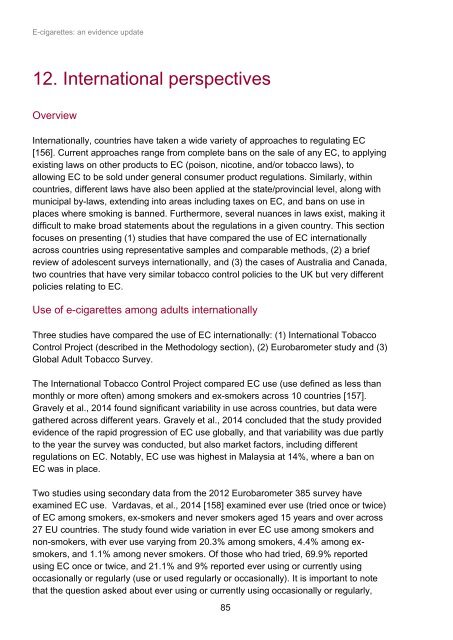E-cigarettes an evidence update A report commissioned by Public Health England
3nOaxpIe4
3nOaxpIe4
You also want an ePaper? Increase the reach of your titles
YUMPU automatically turns print PDFs into web optimized ePapers that Google loves.
E-<strong>cigarettes</strong>: <strong>an</strong> <strong>evidence</strong> <strong>update</strong>12. International perspectivesOverviewInternationally, countries have taken a wide variety of approaches to regulating EC[156]. Current approaches r<strong>an</strong>ge from complete b<strong>an</strong>s on the sale of <strong>an</strong>y EC, to applyingexisting laws on other products to EC (poison, nicotine, <strong>an</strong>d/or tobacco laws), toallowing EC to be sold under general consumer product regulations. Similarly, withincountries, different laws have also been applied at the state/provincial level, along withmunicipal <strong>by</strong>-laws, extending into areas including taxes on EC, <strong>an</strong>d b<strong>an</strong>s on use inplaces where smoking is b<strong>an</strong>ned. Furthermore, several nu<strong>an</strong>ces in laws exist, making itdifficult to make broad statements about the regulations in a given country. This sectionfocuses on presenting (1) studies that have compared the use of EC internationallyacross countries using representative samples <strong>an</strong>d comparable methods, (2) a briefreview of adolescent surveys internationally, <strong>an</strong>d (3) the cases of Australia <strong>an</strong>d C<strong>an</strong>ada,two countries that have very similar tobacco control policies to the UK but very differentpolicies relating to EC.Use of e-<strong>cigarettes</strong> among adults internationallyThree studies have compared the use of EC internationally: (1) International TobaccoControl Project (described in the Methodology section), (2) Eurobarometer study <strong>an</strong>d (3)Global Adult Tobacco Survey.The International Tobacco Control Project compared EC use (use defined as less th<strong>an</strong>monthly or more often) among smokers <strong>an</strong>d ex-smokers across 10 countries [157].Gravely et al., 2014 found signific<strong>an</strong>t variability in use across countries, but data weregathered across different years. Gravely et al., 2014 concluded that the study provided<strong>evidence</strong> of the rapid progression of EC use globally, <strong>an</strong>d that variability was due partlyto the year the survey was conducted, but also market factors, including differentregulations on EC. Notably, EC use was highest in Malaysia at 14%, where a b<strong>an</strong> onEC was in place.Two studies using secondary data from the 2012 Eurobarometer 385 survey haveexamined EC use. Vardavas, et al., 2014 [158] examined ever use (tried once or twice)of EC among smokers, ex-smokers <strong>an</strong>d never smokers aged 15 years <strong>an</strong>d over across27 EU countries. The study found wide variation in ever EC use among smokers <strong>an</strong>dnon-smokers, with ever use varying from 20.3% among smokers, 4.4% among exsmokers,<strong>an</strong>d 1.1% among never smokers. Of those who had tried, 69.9% <strong>report</strong>edusing EC once or twice, <strong>an</strong>d 21.1% <strong>an</strong>d 9% <strong>report</strong>ed ever using or currently usingoccasionally or regularly (use or used regularly or occasionally). It is import<strong>an</strong>t to notethat the question asked about ever using or currently using occasionally or regularly,85


